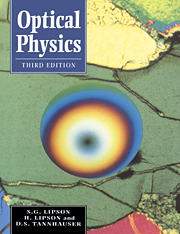Book contents
- Frontmatter
- Contents
- Preface to the third edition
- Preface to the second edition
- Preface to the first edition
- 1 History of ideas
- 2 Waves
- 3 Geometrical optics
- 4 Fourier theory
- 5 Electromagnetic waves
- 6 Polarization and anisotropic media
- 7 Diffraction
- 8 Fraunhofer diffraction and interference
- 9 Interferometry
- 10 Optical waveguides and modulated media
- 11 Coherence
- 12 Image formation
- 13 The classical theory of dispersion
- 14 Quantum optics and lasers
- 15 Problems
- Appendix 1 Bessel functions in wave optics
- Appendix 2 Lecture demonstrations in Fourier optics
- Bibliography
- Index
13 - The classical theory of dispersion
- Frontmatter
- Contents
- Preface to the third edition
- Preface to the second edition
- Preface to the first edition
- 1 History of ideas
- 2 Waves
- 3 Geometrical optics
- 4 Fourier theory
- 5 Electromagnetic waves
- 6 Polarization and anisotropic media
- 7 Diffraction
- 8 Fraunhofer diffraction and interference
- 9 Interferometry
- 10 Optical waveguides and modulated media
- 11 Coherence
- 12 Image formation
- 13 The classical theory of dispersion
- 14 Quantum optics and lasers
- 15 Problems
- Appendix 1 Bessel functions in wave optics
- Appendix 2 Lecture demonstrations in Fourier optics
- Bibliography
- Index
Summary
Classical dispersion theory
Many aspects of the interaction between radiation and matter can be described quite accurately by a classical theory in which the medium is represented by model atoms consisting of positive and negative parts bound by an attraction which depends linearly on their separation. Although quantum theory is necessary to calculate from first principles the magnitude of the parameters involved, in this chapter we shall show that many optical effects can be interpreted physically in terms of this model by the use of classical mechanics. In §13.5 we shall relax the restriction of linearity. Some of the quantum mechanical foundations will be discussed briefly in Chapter 14, but most are outside the scope of this book (see Yariv, 1989; Loudon, 1983).
The term dispersion means the dependence of dielectric response (dielectric constant and refractive index) on frequency of the wave field. This will be the topic of the present section. Afterwards we shall see some of the applications of dielectric response to spatial effects.
The classical atom
Our classical picture of an atom consists of a massive positive nucleus surrounded by a light spherically-symmetrical cloud of electrons with an equal negative charge. We imagine the two as bound together by springs as in Fig. 13.1, so that in equilibrium the centres of mass and charge of the core and electron charge coincide. As a result the static atom has zero dipole moment.
- Type
- Chapter
- Information
- Optical Physics , pp. 383 - 406Publisher: Cambridge University PressPrint publication year: 1995

